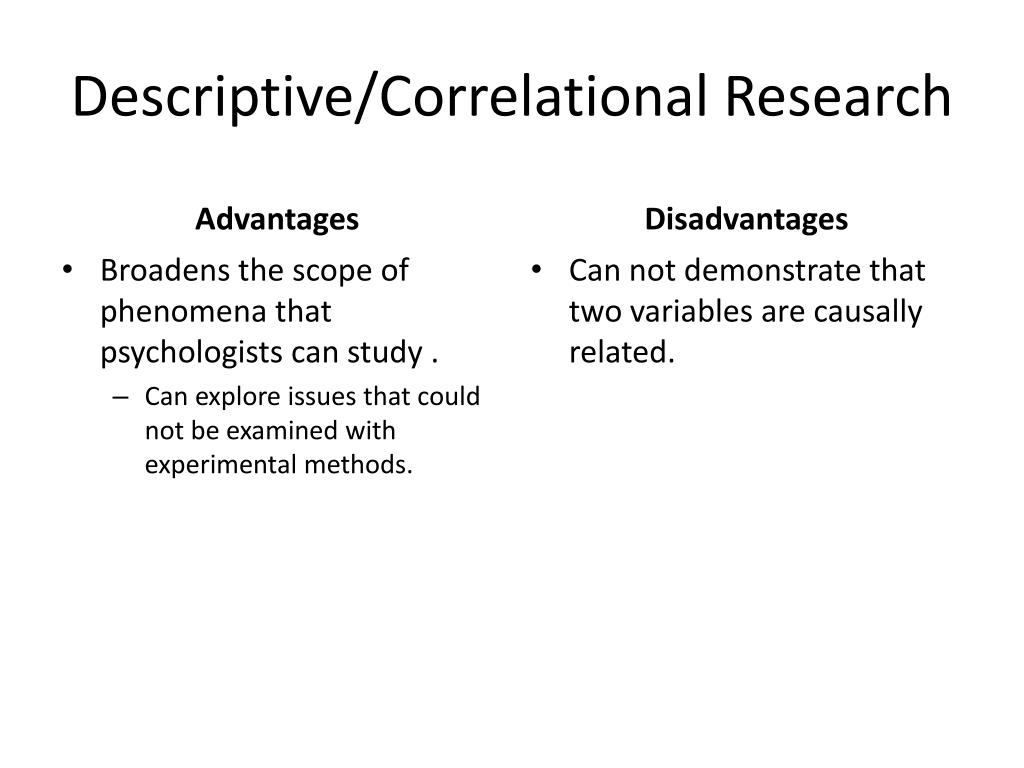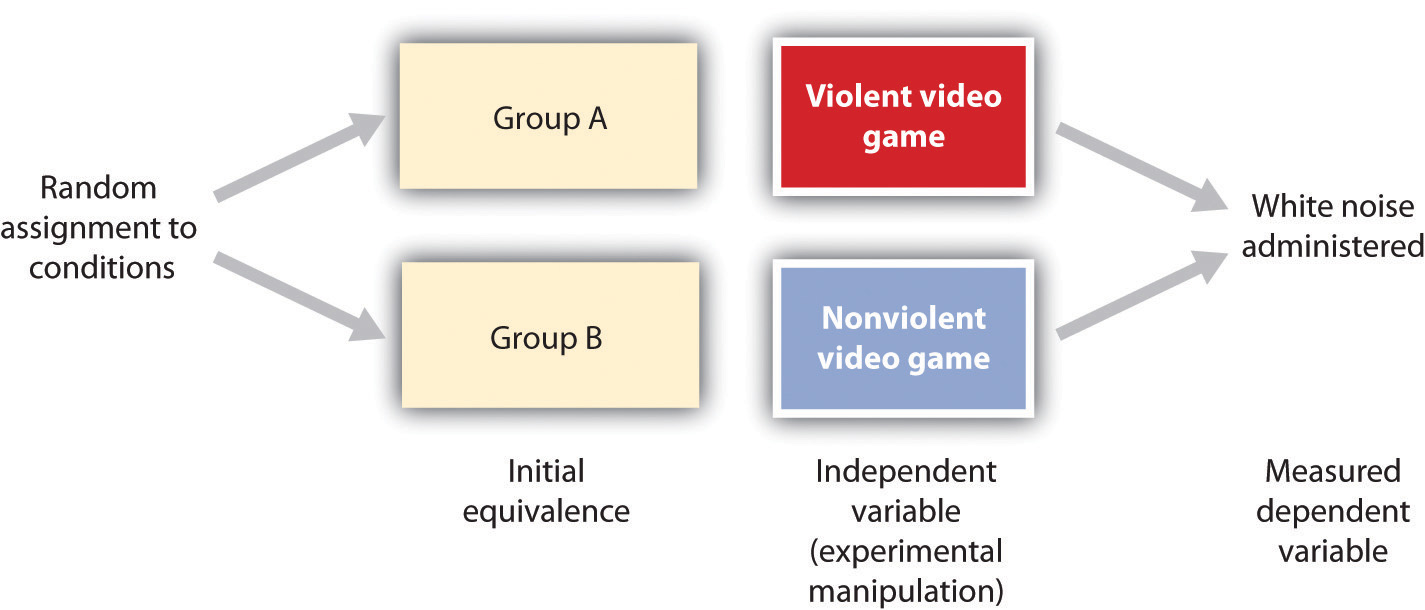Table Of Content

Although this “feels” like a between-subjects experiment, it is a correlational study because the researcher did not manipulate the students’ nationalities. The same is true of the study by Cacioppo and Petty comparing college faculty and factory workers in terms of their need for cognition. It is a correlational study because the researchers did not manipulate the participants’ occupations. A common misconception among beginning researchers is that correlational research must involve two quantitative variables, such as scores on two extraversion tests or the number of hassles and number of symptoms people have experienced. A common misconception among beginning researchers is that correlational research must involve two quantitative variables, such as scores on two extroversion tests or the number of hassles and number of symptoms people have experienced. Imagine, for example, that a researcher administers the Rosenberg Self-Esteem Scale to 50 American university students and 50 Japanese university students.
(PDF) The Influence of Service Quality on Customer Engagement in Kaputian Beach Park - ResearchGate
(PDF) The Influence of Service Quality on Customer Engagement in Kaputian Beach Park.
Posted: Wed, 07 Feb 2024 08:00:00 GMT [source]
Correlation Studies in Psychology Research
Correlational research is a type of non-experimental research in which the researcher measures two variables and assesses the statistical relationship (i.e., the correlation) between them with little or no effort to control extraneous variables. Recall two goals of science are to describe and to predict and the correlational research strategy allows researchers to achieve both of these goals. Figure 6.2 shows data from a hypothetical study on the relationship between whether people make a daily list of things to do (a “to-do list”) and stress. Notice that it is unclear whether this is an experiment or a correlational study because it is unclear whether the independent variable was manipulated. If the researcher randomly assigned some participants to make daily to-do lists and others not to, then it is an experiment.
Does your Research Methodology Have the Following?

Figure 7.2 shows data from a hypothetical study on the relationship between whether people make a daily list of things to do (a “to-do list”) and stress. Notice that it is unclear whether this design is an experiment or a correlational study because it is unclear whether the independent variable was manipulated. But if it was a correlational study, it could only be concluded that these variables are related. A common misconception among beginning researchers is that correlational research must involve two quantitative variables, such as scores on two extraversion tests or the number of daily hassles and number of symptoms people have experienced. However, the defining feature of correlational research is that the two variables are measured—neither one is manipulated—and this is true regardless of whether the variables are quantitative or categorical. Imagine, for example, that a researcher administers the Rosenberg Self-Esteem Scale to 50 American college students and 50 Japanese college students.
Data collection
Failing to account for third variables can lead to spurious correlations or erroneous conclusions about causality. As with any research methodology, correlational studies have inherent considerations and limitations that researchers must acknowledge and address to ensure the validity and reliability of their findings. This is what correlational research precisely is, establishing a relationship between two variables, “jingle” and “distance of the truck” in this particular example. The correlational study looks for variables that seem to interact with each other. When you see one variable changing, you have a fair idea of how the other variable will change.

To address the influence of third variables, researchers can employ various strategies, such as statistical control techniques, experimental designs (when feasible), and careful operationalization of variables. In contrast to naturalistic observation, the information collected through archived data can be pretty straightforward. For example, counting the number of people named Richard in the various states of America based on social security records is relatively short.
Chapter 12 Methods for Correlational Studies
Correlation: Meaning, Strength, and Examples - Verywell Mind
Correlation: Meaning, Strength, and Examples.
Posted: Thu, 30 Nov 2023 08:00:00 GMT [source]
Once you have collected your data in a correlational study, the next crucial step is to analyze it effectively to draw meaningful conclusions about the relationship between variables. The correlation coefficient is a statistical measure that quantifies the strength and direction of the relationship between two variables. While the inability to change variables can be a disadvantage of some methods, it can be a benefit of archival research.
Psychological Correlational Studies
The aim of descriptive research is to provide an accurate and detailed portrayal of a particular group, event, or situation. It can be useful in identifying patterns, trends, and relationships in the data. The observers committed this list to memory and then practised by coding the reactions of bowlers who had been videotaped.
An example is when an increase in workers’ remuneration results in an increase in the prices of goods and services and vice versa. In this chapter we described cohort, case-control and cross-sectional studies as three types of correlational studies used in eHealth evaluation. The methodological issues addressed include bias and confounding, controlling for confounders, adherence to good practices and consistency in reporting. Three case examples were included to show how eHealth correlational studies are done.
Correlational vs experimental research
Formplus is a great online data-gathering platform that you can use to create custom survey forms for correlational research. You can customize your correlational research survey form by adding background images, new color themes or your company logo to make it appear even more professional. In addition, Formplus also has a survey form template that you can edit for a correlational research study. To use an online form for a correlational research survey, you would need to sign up on a data-gathering platform like Formplus. Formplus allows you to create custom forms for correlational research surveys using the Formplus builder.
Researchers use two data collection methods to collect information in correlational research. To determine why the relationship exists, researchers would need to consider and experiment with other variables, such as the subject's social relationships, cognitive abilities, personality, and socioeconomic status. For example, researchers might perform a correlational study that suggests there is a relationship between academic success and a person's self-esteem. However, the study cannot show that academic success changes a person's self-esteem.
For example, being educated might negatively correlate with the crime rate when an increase in one variable leads to a decrease in another and vice versa. It only means that a lack of education and crime is believed to have a common reason – poverty. Many areas of psychological research benefit from analyzing studies that were conducted long ago by other researchers, as well as reviewing historical records and case studies. For example, there is zero correlation between a person’s shoe size and their IQ score. Similarly, there is zero correlation between a person’s height and their favorite color.
This method is extremely demanding as the researcher must take extra care to ensure that the subjects do not suspect that they are being observed else they deviate from their natural behavior patterns. It is best for all subjects under observation to remain anonymous in order to avoid a breach of privacy. Sporadic change patterns that occur in variables with zero correlational are usually by chance and not as a result of corresponding or alternate mutual inclusiveness. A cross-sectional survey is a type of cross-sectional study where the data source is drawn from postal questionnaires and interviews.
In general, correlational research is high in external validity while experimental research is high in internal validity. Research design refers to the overall strategy or plan for conducting a research study. It outlines the methods and procedures that will be used to collect and analyze data, as well as the goals and objectives of the study. Research design is important because it guides the entire research process and ensures that the study is conducted in a systematic and rigorous manner. An approach to data collection that involves observing people’s behaviour in the environment in which it typically occurs. Another approach to correlational research is the use of archival data, which are data that have already been collected for some other purpose.

No comments:
Post a Comment